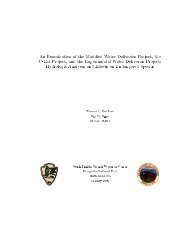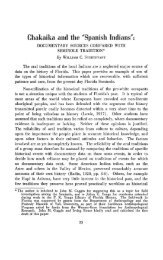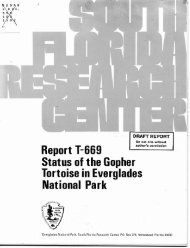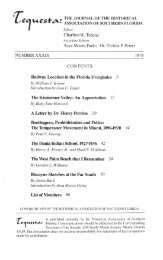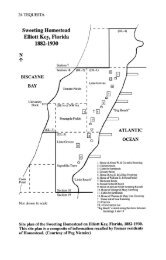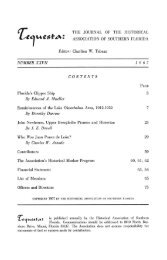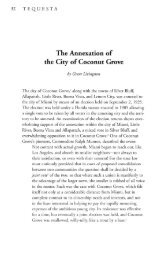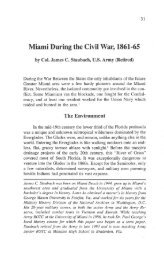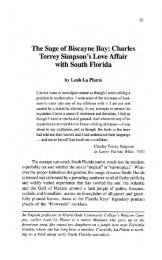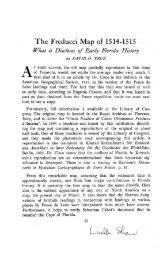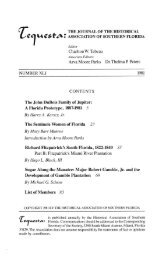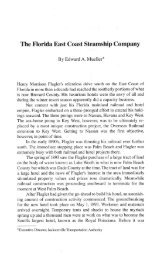Tequesta : Number - 50/1990 - FIU Digital Collections
Tequesta : Number - 50/1990 - FIU Digital Collections
Tequesta : Number - 50/1990 - FIU Digital Collections
Create successful ePaper yourself
Turn your PDF publications into a flip-book with our unique Google optimized e-Paper software.
34 TEQUESTA<br />
In the early 19<strong>50</strong>s, Hal Moore returned from Cuba with seeds he had<br />
collected from a rare palm growing at Harvard University's Atkins<br />
Garden near Cienfuegos. We planted several seeds and grew a fine<br />
specimen near a comer of our bedroom. With its several slender green<br />
trunks resembling large bamboo, this cluster palm grew to 20 feet. The<br />
origin of this mysterious palm was never solved. No one, including Hal,<br />
was able to find it growing wild in any part of the world, nor was it<br />
mentioned in botanical literature. Many years ago a ship's physician, a<br />
Dr. Cabada, collected the seeds while on a voyage - to Madagascar,<br />
Hal believed. At the time of Cabada's death a fruiting specimen grew<br />
in his garden at Cienfuegos. The garden was neglected, however, and<br />
the palm might have been lost except for the interest of Robert M. Grey,<br />
director of Atkins Garden, who collected seeds from the unidentified<br />
species and planted them. Hal immediately recognized the palm as<br />
being in the genus Chrysalidocarpus, but the species was as much a<br />
mystery to him as it had been to Grey. Hal waited 10 years to describe<br />
the palm as a new species and give it a name, hoping that someone in<br />
the meantime would discover its nativity. Meanwhile the palm was<br />
widely planted in South Florida as the "Cabada palm." When Hal finally<br />
gave it a botanical name, he honored the physician who introduced it to<br />
cultivation by calling it Chrysalidocarpus cabadae. Unfortunately the<br />
Cabada palm proved susceptible to the lethal yellow disease, which<br />
wiped out most of the common coconuts of South Florida and a number<br />
of other palms. We lost our beautiful Cabada palm along with all our<br />
coconuts except the Malay variety which is resistant to the disease.<br />
One of our favorite small palms was the native Thrinaxfloridana,<br />
which grows abundantly in South Florida, the Bahamas and the West<br />
Indies. It is well adapted to limestone soil and to the warmer coastal<br />
areas and the keys. Once established, it requires no further attention--<br />
no sprays for insects or diseases and no irrigation during the dry season.<br />
Its growth is slow; but in its early years it makes an excellent screen; and<br />
you are reluctant to see it grow taller, raising new fan-shaped leaves<br />
above the screening level as older lower leaves die.<br />
Bahama plants are particularly well adapted to South Florida because<br />
the soil and the climate of the two areas are similar. I grew 20 species<br />
of Bahama plants at Montgomery Drive, most of them collected by Dr.<br />
John Popenoe, who succeeded me as director of the Fairchild Garden.<br />
Once a Bahama plant is thoroughly established, it requires no further<br />
care, except a little fertilizer from time to time to promote growth.



